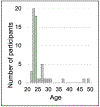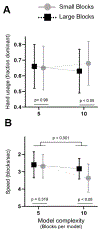Healthy adults favor stable left/right hand choices over performance at an unconstrained reach-to-grasp task
- PMID: 38563977
- PMCID: PMC11506212
- DOI: 10.1007/s00221-024-06828-5
Healthy adults favor stable left/right hand choices over performance at an unconstrained reach-to-grasp task
Abstract
Reach-to-grasp actions are fundamental to the daily activities of human life, but few methods exist to assess individuals' reaching and grasping actions in unconstrained environments. The Block Building Task (BBT) provides an opportunity to directly observe and quantify these actions, including left/right hand choices. Here we sought to investigate the motor and non-motor causes of left/right hand choices, and optimize the design of the BBT, by manipulating motor and non-motor difficulty in the BBT's unconstrained reach-to-grasp task. We hypothesized that greater motor and non-motor (e.g. cognitive/perceptual) difficulty would drive increased usage of the dominant hand. To test this hypothesis, we modulated block size (large vs. small) to influence motor difficulty, and model complexity (10 vs. 5 blocks per model) to influence non-motor difficulty, in healthy adults (n = 57). Our data revealed that increased motor and non-motor difficulty led to lower task performance (slower task speed), but participants only increased use of their dominant hand only under the most difficult combination of conditions: in other words, participants allowed their performance to degrade before changing hand choices, even though participants were instructed only to optimize performance. These results demonstrate that hand choices during reach-to grasp actions are more stable than motor performance in healthy right-handed adults, but tasks with multifaceted difficulties can drive individuals to rely more on their dominant hand.
Keywords: (4 to6): hand choice; Block-building task; Reaching and grasping; Task difficulty.
© 2024. The Author(s), under exclusive licence to Springer-Verlag GmbH Germany, part of Springer Nature.
Figures






Update of
-
Healthy adults favor stable left/right hand choices over performance at an unconstrained reach-to-grasp task.bioRxiv [Preprint]. 2023 Oct 16:2023.10.11.561912. doi: 10.1101/2023.10.11.561912. bioRxiv. 2023. Update in: Exp Brain Res. 2024 Jun;242(6):1349-1359. doi: 10.1007/s00221-024-06828-5. PMID: 37904957 Free PMC article. Updated. Preprint.
Similar articles
-
Healthy adults favor stable left/right hand choices over performance at an unconstrained reach-to-grasp task.bioRxiv [Preprint]. 2023 Oct 16:2023.10.11.561912. doi: 10.1101/2023.10.11.561912. bioRxiv. 2023. Update in: Exp Brain Res. 2024 Jun;242(6):1349-1359. doi: 10.1007/s00221-024-06828-5. PMID: 37904957 Free PMC article. Updated. Preprint.
-
Manual asymmetries in grasp pre-shaping and transport-grasp coordination.Exp Brain Res. 2008 Jun;188(2):305-15. doi: 10.1007/s00221-008-1364-2. Epub 2008 Apr 25. Exp Brain Res. 2008. PMID: 18437369
-
Characteristic brain functional activation and connectivity during actual and imaginary right-handed grasp.Brain Res. 2024 Dec 1;1844:149141. doi: 10.1016/j.brainres.2024.149141. Epub 2024 Aug 7. Brain Res. 2024. PMID: 39122137
-
An investigation into manual asymmetries in grasp behavior and kinematics during an object manipulation task.Exp Brain Res. 2011 Nov;215(1):65-75. doi: 10.1007/s00221-011-2872-z. Epub 2011 Sep 22. Exp Brain Res. 2011. PMID: 21938544
-
On the Neurocircuitry of Grasping: The influence of action intent on kinematic asymmetries in reach-to-grasp actions.Atten Percept Psychophys. 2019 Oct;81(7):2217-2236. doi: 10.3758/s13414-019-01805-5. Atten Percept Psychophys. 2019. PMID: 31290131 Review.
Cited by
-
Block Building Task Identifies Distinct Groups of Left/Right-hand Choice Patterns After Unilateral Peripheral Nerve Injury.J Vis Exp. 2025 Mar 21;(217):10.3791/66919. doi: 10.3791/66919. J Vis Exp. 2025. PMID: 40193320 Free PMC article.
References
-
- Bootsma JM, Hortobágyi T, Rothwell JC, Caljouw SR (2018) The role of task difficulty in learning a visuomotor skill. Medicine and Science in Sports and Exercise 50:1842–1849 - PubMed
MeSH terms
Grants and funding
LinkOut - more resources
Full Text Sources

